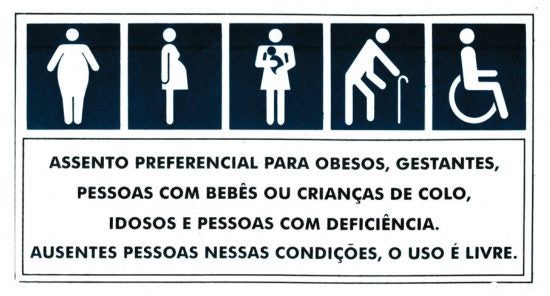
Public transport in Rio de Janeiro has a unique feature. It’s not the song you hear taking the metro every morning, or the moving and often indecipherable poems you can read on its walls, but the new sign introduced this January for priority seating. In addition to the commonly protected groups (pregnant women, elderly, and disabled) a new cause appears to justify specific protections: obesity.
What may seem trivial points to a bigger and much more serious issue, raising awareness about what has been described by the WHO as “one of the most blatantly visible -yet most neglected- public health problems”. Obesity and overweight constitute major risk factors of chronic or noncommunicable diseases (NCDs), with the latter being responsible for 70% of all deaths globally. Despite its proven harmful effects, it constitutes an escalating global epidemic that countries have struggled to contain or reduce. Obesity is enormously influenced by biopsychosocial processes; where the social, political, and cultural environment constrain and sometimes predetermine individual choices.
In Brazil, the weight of these factors is illustrated through the internal divides of the population. Obesity and poverty go hand-in-hand in Brazill. Even more surprising is that this connection predominantly involves the female population, with men displaying the opposite tendency. To put this into numbers, according to the UN Food and Agriculture Organization (FAO), more than half of the Brazilian population is overweight and 20% are classified as obese, with a higher prevalence among women at 22.7%. The prevalence of obesity among women increase as their income, level of education, and standards of equal treatment decrease. In contrast, even though the overall difference between genders seem to be insignificant, the percentage of overweight men grows as income increases, and has reached 61.8% in the wealthiest populations.
This difference can be explained by many factors, among them are the gender-based divisions of labor. In the poorest populations, professions that employ the use of physical strength are mostly performed by men; with women often being relegated to the household. Nevertheless, at lunchtime, both ingest a low-cost high caloric diet, for example, the traditional “arroz e feijão” (rice and beans). Besides, these women tend to sacrifice their own diet in benefit of their husbands and children, giving them the better quality food, with more nutrients and less fat.
Also, the influence of cultural factors and different beauty standards should be analyzed. In Brazilian impoverished communities, an overweight body acquires a symbolic value as a sign of strength, power and sensuality. The opposite extreme can be found in the female more affluent strata. They equate thinness with beauty, not always in a healthy way. Thus, despite the socio-economic status, women seen themselves pressed to respect a prototype of beauty and size of body. A pressure that men seem not bear on their shoulders. Is the old perception of higher weight as a symbol of social status being perpetuated among men?
Understanding how obesity relates to gender and socioeconomic status, as well as the cultural particularities of a country, are key factors to offer effective measures to fight the dimensions of the obesity problem. Brazil is one example of a nation struggling to make progress on obesity despite successful public health campaigns in the areas of tobacco and alcoholism. Therefore, this failure might be explained by the difficulty addressing all the socioeconomic and cultural factors behind obesity. Elements that should be considered for a real change to take place.
*Image courtesy of Centerbuspecas



